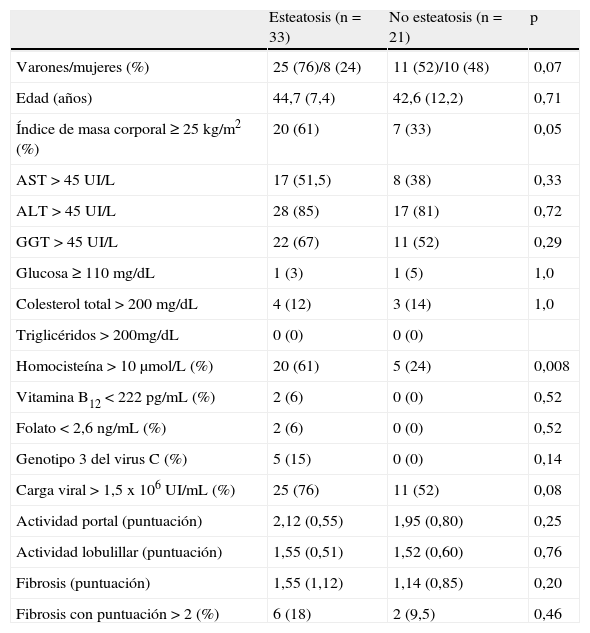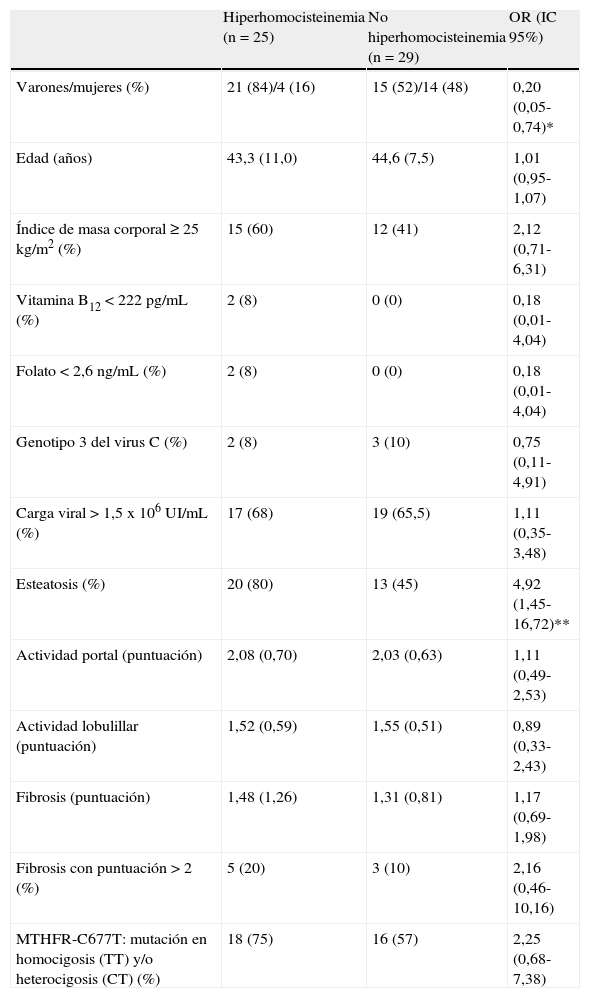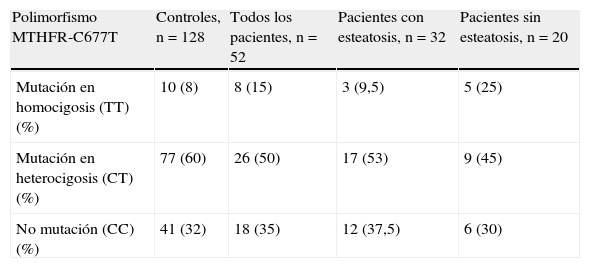La esteatosis hepática en la hepatitis crónica C (HCC) se relaciona con factores virales, metabólicos y posiblemente genéticos. El objetivo de este estudio es conocer si la hiperhomocisteinemia y el polimorfismo de la metilentetrahidrofolato reductasa (MTHFR)-C677T se asocian a esteatosis hepática en pacientes no alcohólicos con HCC.
Pacientes y métodoSe estudiaron 54 pacientes consecutivos diagnosticados de HCC mediante biopsia, con consumo de alcohol menor de 40g/semana, y sin otras causas de enfermedad hepática. Todas las variables se obtuvieron al tiempo de la biopsia. En 128 sujetos sanos, con edad y sexo similares a los pacientes, también se determinó el polimorfismo de la MTHFR-C677T.
ResultadosSe encontró esteatosis hepática en 33 pacientes (61%), siendo en 30 de grado leve. En los pacientes con esteatosis existía una prevalencia más elevada de hiperhomocisteinemia (61% frente al 24%, p=0,008) y el sobrepeso tendía a ser más prevalente (61% frente al 33%, p=0,05). Todos los pacientes con genotipo 3 del virus C tenían esteatosis. La carga viral, actividad inflamatoria y fibrosis hepática no fueron diferentes en los pacientes con y sin esteatosis. El polimorfismo de la MTHFR-C677T fue similar en controles y casos, y en los casos con y sin esteatosis. La regresión logística múltiple mostró que la hiperhomocisteinemia se asociaba a esteatosis hepática tras ajustar por edad y sexo (odds ratio [OR] 3,94, intervalo de confianza del 95% [IC 95%] 1,09-14,29) y por sobrepeso (OR 4,43, IC 95% 1,27-15,51).
ConclusionesEn pacientes no alcohólicos con HCC, la esteatosis hepática de grado leve es frecuente y se asocia a hiperhomocisteinemia. No se comprueba asociación de la esteatosis con el polimorfismo de la MTHFR-C677T.
Liver steatosis in chronic hepatitis C (CHC) is related to viral and metabolic factors and likely to genetic factors. The aim of this study was to know if hyperhomocysteinemia and methylenetetrahydrofolate reductase (MTHFR)-C677T polymorphisms are associated with liver steatosis in nonalcoholic patients with CHC.
Patients and methodIn 54 consecutive patients with CHC, alcohol consumption less than 40g/week, and no other causes of liver disease, a liver biopsy was performed. All variables were obtained at the time of biopsy. MTHFR-C677T was also performed in 128 healthy subjects, with age and gender similar to the patients.
ResultsLiver steatosis was found in 33 patients (61%), 30 of them having a mild degree. Hyperhomocysteinemia was more prevalent in patients with steatosis (61% vs 24%; p=0.008) and overweight tended to be more prevalent in the same patients (61% vs 33%; p=0.05). All patients with virus C genotype 3 had steatosis. Viral load, liver inflammatory and fibrosis score were not different in patients with and without steatosis. MTHFR-C677T polymorphism was similar in controls and cases and in cases with and without steatosis. A multiple logistic regression showed that hyperhomocysteinemia was associated with liver steatosis after adjustment for age and sex (OR: 3.94; 95% CI: 1.09-14.29), and adjustment for overweight (OR: 4.43; 95% CI: 1.27-15.51).
ConclusionsIn nonalcoholic patients with CHC mild liver steatosis is frequent, and is associated with hyperhomocysteinemia. An association between steatosis and MTHFR-C677T polymorphism was not found.
Artículo
Comprando el artículo el PDF del mismo podrá ser descargado
Precio 19,34 €
Comprar ahora










